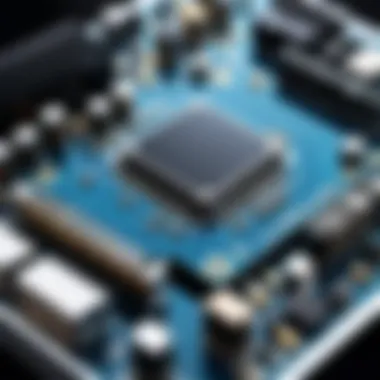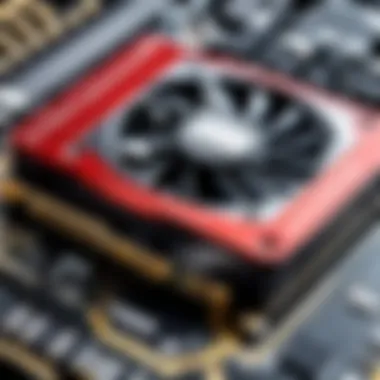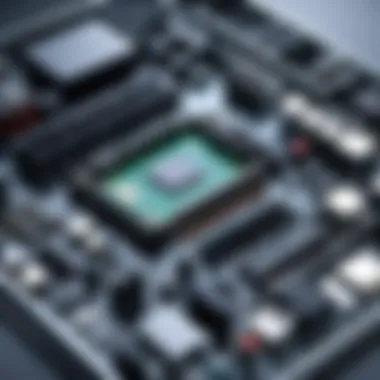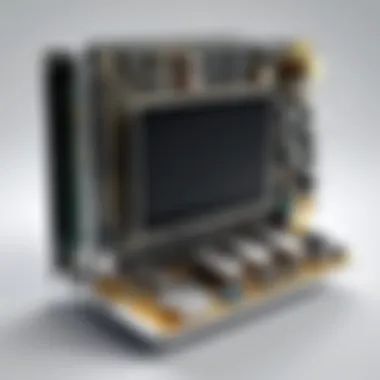Exploring CDW Computer Parts: A Comprehensive Guide


Intro
In the modern landscape of technology, understanding the components that compose a computer is essential. As systems become more complex, the demand for diverse computer parts increases. This guide offers an extensive look into the variety of parts available through CDW. It serves both tech enthusiasts and casual users who seek clarity in navigating the multifaceted world of computer hardware.
Understanding specifications, compatibility, and performance metrics is critical for choosing the right components. From gamers seeking top-tier performance to builders focused on practical applications, having knowledge of these elements can drastically improve user experience. This guide aims to provide a coherent narrative about computer parts, enabling informed purchasing decisions.
Technical Specifications
The technical specifications of computer parts play a key role in determining their functionality and suitability for various tasks. It is crucial to grasp these specs when considering components from CDW.
Detailed Product Specs
When examining every type of computer part, specifications such as size, form factor, and connectivity are significant. For instance, graphics cards have intricate specifications involving memory type, bandwidth, and clock speeds. Understanding these details can help users select the right graphics card based on their performance needs.
Performance Metrics
A component’s performance metrics often define its effectiveness in particular applications. In processors, metrics such as clock speed, core count, and thermal design power (TDP) impact overall performance. Users must analyze these metrics to ensure they select the optimal processor for gaming or performing intensive computational tasks.
Compatibility Information
Compatibility is another vital consideration. Before purchasing, users should ensure that components like motherboards, CPUs, and RAM work seamlessly together. For example, RAM speed should align with motherboard specifications. CDW provides user information to avoid compatibility issues that can arise from misaligned component choices.
Product Comparisons
Evaluating different products allows users to make informed decisions based on features, prices, and experiences.
Feature Comparisons
Different brands offer varying features within similar components. For instance, when comparing the Samsung 970 EVO Plus and the Western Digital Black SN750 SSD, users should analyze features such as read/write speeds and thermal throttling performance.
Price Breakdown
Price plays a pivotal role in purchasing decisions. Users should consider not just the base price but also the performance per dollar. High-end components might appear expensive initially, but understanding their value in context can justify the investment. CDW typically provides comprehensive pricing structures to assist in these decisions.
User Experience Breakdown
Reviews and user experiences provide insights beyond mere specifications. Prospective buyers can benefit from feedback about reliability, warranty support, and overall satisfaction. Engaging with community platforms, such as Reddit, helps gather opinions from actual users who have tested these components in real-world scenarios.
Practical Applications
Different users have distinct needs. Understanding practical applications can enhance the relevance of component selections.
Use Cases for Different Users
Gamers often prioritize performance, requiring powerful graphics cards and efficient cooling systems. In contrast, office users might need dependability without ultra-high specs. Recognizing the needs of different user groups is integral to selecting the appropriate components.
Recommended Configurations
For gamers, a common recommended configuration might involve an NVIDIA GeForce RTX 3070 coupled with a Ryzen 7 5800X CPU. This combination provides significant power for most gaming applications. For everyday users, an Intel Core i5 with an SSD for quick boot times may suffice.
Multi-Platform Performances
Some components provide better performance across platforms. For example, cross-platform compatibility can enhance experiences in gaming sessions across PC or console. Understanding these configurations can reshape users' expectations and experience.
Latest Trends
Staying current with trends is invaluable for any tech consumer. Trends can influence product availability, performance expectations, and future purchases.
Industry Developments
Recent developments such as DDR5 RAM and PCIe 4.0 have showcased significant improvements in data transfer rates and overall performance. These advancements require consumers to reconsider older technologies and integrate new ones that can lead to better overall outcomes.
Emerging Technologies
Technologies like AI-optimized components are on the rise, offering adaptive performance that can fulfill user demands dynamically. Keeping an eye on such technolgies ensures consumers are making relevant and future-proof choices.


Future Predictions
As technology continues to evolve, with newer generations of components released annually, staying informed is crucial. Anticipating the shifts in industry trends, like the potential impact of quantum computing, may influence both purchases and user experiences in the long term.
Buying Guides
Navigating through the vast array of products can be daunting. Buying guides simplify this process.
Recommended Products
While there is no one-size-fits-all recommendation, components like the ASUS ROG Strix B550-F motherboard and Corsair Vengeance LPX RAM are well-regarded for many builds. Curation of trusted products can help streamline choices.
Purchasing Tips
Shoppers should always check for compatibility, warranty, and potential for future upgrades before solidifying their choice. Researching different retail avenues, including CDW, allows for distinct perspectives on best products available.
Warranty and Support Information
Warranties help secure investments in technology. Understanding coverage can mitigate risks associated with hardware failures. Always review the warranty terms provided by manufacturers and resellers before making a final decision.
By understanding the essentials of computer components, users can navigate the intricate world of technology confidently. Preparedness leads to better choices and a rewarding computing experience.
Prolusion to CDW Computer Parts
In the ever-changing world of technology, understanding computer parts is essential. CDW provides a wide selection of computer components. Knowing what CDW offers can enable users to make informed decisions. This article focuses on the importance of these components.
Understanding CDW computer parts helps in various ways. For tech enthusiasts, having the right information leads to better builds. Gamers can enhance their play by knowing which graphic cards boost performance. PC builders can create customized systems based on specific needs.
CDW stands out for its broad catalog. The company features everything from basic components to advanced systems. Each part comes with specifications detailing its capabilities. This allows users to compare and evaluate based on their requirements.
Selecting the right CDW parts involves considerations that go beyond price. Compatibility is a major factor. Users need to ensure components work well together. For example, a powerful CPU requires a suitable motherboard to function to its full potential.
"Choosing the correct parts isn’t just about brand names. It’s about understanding what each component brings to the overall system."
Another point to consider is performance metrics. High benchmarks often indicate robust performance but go hand in hand with usability. Users often look for a balance between high power and efficient use.
Overall, exploring CDW computer parts offers invaluable insights. This section lays the groundwork for understanding the vast array of components available and their significance in both personal and professional settings.
Understanding Computer Components
Understanding computer components is crucial for anyone looking to build or upgrade a computer system. Knowledge of these parts helps in selecting compatible and effective hardware. Each component carries specific functions that contribute to the machine's overall performance. Without a thorough grasp of these elements, making sound purchasing decisions becomes difficult. This is particularly important for tech enthusiasts, gamers, and builders aiming at optimizing their setups.
The Role of Each Part
Every computer comprises various parts, each serving distinct functions. The main components include:
- Central Processing Unit (CPU): Often termed the brain of the computer, the CPU processes instructions. Speed and cores are vital metrics to consider when evaluating CPUs.
- Graphics Processing Unit (GPU): The GPU is essential for rendering images and video. High-performance GPUs are especially beneficial for gaming and graphic design.
- Motherboard: This is the backbone of the computer, interconnecting all components. It provides slots for RAM, CPU, and expansion cards.
- Random Access Memory (RAM): This volatile memory temporarily stores data for active processes. More RAM allows for smoother multitasking and enhances performance, especially in gaming.
- Storage Devices: Hard Disk Drives (HDDs) and Solid State Drives (SSDs) are responsible for storing data. SSDs offer faster read and write speeds compared to HDDs, significantly impacting boot times and file access.
- Power Supply Unit (PSU): The PSU converts electricity from the wall into usable power for computer components. Selecting an adequate PSU is crucial; an inefficient one can lead to instability or hardware failure.
- Cooling Systems: These maintain optimal temperatures, preventing components from overheating. Effective cooling can increase longevity and performance of parts.
- Casing and Chassis: The case houses all components and affects airflow and aesthetics. A good chassis helps in organizing wires and promoting efficient cooling.
Being familiar with the role of each part enables users to make informed choices tailored to their specific needs.
Integration of Components
The integration of components is pivotal. All hardware must function closely together. Compatibility is the primary concern. For instance, selecting a CPU requires knowledge of motherboard chipsets. Some chipsets work with specific CPU generations. Using the wrong motherboard risks performance loss or damage.
Moreover, RAM speed and type affect how well the CPU performs. The motherboard has a direct influence over the amount of RAM supported and its compatibility with CPU and GPU.
Additionally, the PSU's wattage must match the total power needs of the system. If the components draw more power than the PSU can supply, the system may become unstable or fail to boot.
All compnents have to work cohesively, ensuring the system's reliability. Understanding these relationships prevents issues that can arise from poor selection.
"Incompatible hardware can lead to performance bottlenecks, instability, and even hardware damage."
In summary, comprehending the integration of computer parts is just as essential as knowing their individual roles. This knowledge allows for a harmonious assembly that aligns with performance expectations and optimizes the computing experience.
Categories of CDW Computer Parts
Understanding the categories of computer parts available from CDW is crucial for anyone looking to build or upgrade a computer. Each component plays a specific role, and choosing the right combination can enhance performance and ensure compatibility. This section provides insights into key categories of computer components along with their significance, benefits, and considerations.


Processors (CPUs)
The CPU, or Central Processing Unit, serves as the brain of the computer. It performs computations and executes tasks across applications. Choosing the right CPU is vital; a more powerful CPU can handle complex applications and multitasking more efficiently. Factors to consider include clock speed, core count, and thermal design power. Popular models such as the Intel Core i9 and AMD Ryzen 9 provide advanced capabilities for high-performance work.
Graphics Cards (GPUs)
Graphics cards are fundamental for rendering images, videos, and graphics in applications and games. The importance of GPUs has grown, particularly for gamers and creative professionals. They manage heavy graphic loads that CPUs cannot efficiently handle alone. When selecting a GPU, one should consider memory size, performance benchmarks, and power requirements. Notable options include the NVIDIA GeForce RTX series and the AMD Radeon RX lineup, which offer superior performance for demanding tasks.
Motherboards
The motherboard acts as the main printed circuit board that connects all components of the computer. It hosts the CPU, RAM, and provides expansion slots for GPUs and other peripherals. Choosing a suitable motherboard involves looking at form factors, such as ATX or microATX, connectivity options like USB ports, and compatibility with other parts. Brands like ASUS, MSI, and Gigabyte provide various options to fit different computing needs.
Memory (RAM)
RAM, or Random Access Memory, temporarily stores data for programs currently in use. More RAM allows a computer to handle more tasks simultaneously. In general, 8GB is considered adequate for basic tasks, while 16GB or more is recommended for gaming or content creation. When selecting RAM, pay attention to its speed (measured in MHz) and type (DDR4, for example), as these can impact performance significantly.
Storage Solutions
Storage solutions encompass both Solid State Drives (SSDs) and Hard Disk Drives (HDDs), each serving distinct purposes in data management.
Solid State Drives (SSD)
Solid State Drives offer faster data access and improved performance than traditional HDDs. The key characteristic of SSDs is their use of flash memory, which decreases load times for applications and operating systems. This speed advantage makes SSDs a popular choice for gaming and professional use. Moreover, SSDs are more durable since they have no moving parts. However, they tend to be more expensive per gigabyte than HDDs.
Hard Disk Drives (HDD)
Hard Disk Drives, while slower than SSDs, provide larger storage capacities at a lower cost. The primary characteristic of HDDs is their mechanical nature, which uses spinning disks to read and write data. They are a beneficial choice for storing large files and backups. However, they are more susceptible to mechanical failure and offer slower performance compared to SSDs. Individuals who need extensive storage without high speed requirements may find HDDs more useful for their computations.
Power Supplies
Power supplies convert electrical power from an outlet into usable power for the computer's components. Choosing an appropriate power supply is essential for system stability. Consider the wattage rating and efficiency ratings, such as 80 PLUS certifications, which indicate energy efficiency. Reliable brands include Corsair and EVGA, ensuring longevity and performance for the entire system.
Cooling Systems
Cooling systems are critical to prevent overheating of components, especially under heavy workloads. Air cooling and liquid cooling are the primary methods available. Air coolers tend to be easier to install and maintain, while liquid coolers can provide superior cooling efficiency. Both methods have their unique installation requirements and costs, so choose based on your system’s cooling needs.
Casing and Chassis
The casing or chassis houses all components of the computer. It plays a vital role in airflow, cooling efficiency, and aesthetics. When selecting a case, consider the size, airflow design, and material. Cases from manufacturers like NZXT and Fractal Design offer both functionality and style, catering to various preferences and setups.
Specifics of Choosing CDW Parts
When selecting computer parts from CDW, several specifics come into play. Understanding these specifics is crucial for ensuring that the chosen components align with individual performance needs and technical requirements. This section focuses on three primary aspects: compatibility considerations, performance metrics, and cost analysis. Each of these elements informs the decision-making process for tech-savvy consumers, gamers, and PC builders alike.
Compatibility Considerations
Compatibility between components is fundamental in computer building. A component's ability to function within a particular system is paramount. When assessing compatibility, several factors must be evaluated:
- Form Factor: Ensure that the physical dimensions of parts, such as motherboards and graphic cards, fit the case.
- Socket Type: Different processors utilize specific socket types. Selecting the wrong one can lead to installation failures.
- Power Requirements: Verify that the power supply unit can provide enough wattage and the correct connectors for the components.
Incompatibility can lead to performance issues or even hardware damage. Thus, examining these factors carefully can save time and expense down the line.
Performance Metrics
Performance metrics highlight how well computer parts operate under various conditions. This section will cover benchmarks and usability, two critical facets of performance evaluation.
Benchmarks
Benchmarks provide quantifiable data on component performance. They are standardized tests that measure a component's capabilities against set criteria. This is particularly useful in:
- Comparative Analysis: Users can evaluate parts based on performance scores.
- Expectations Setting: Knowing the benchmarks sets realistic expectations for system performance.
One key characteristic of benchmarks is their industry-wide acceptance, allowing for trusted comparisons across brands. A common benchmark tool is 3DMark, which assesses graphical performance. However, benchmarks can have limitations, such as varying results based on system settings or configurations. Users must take these factors into account when interpreting benchmark data.
Usability


Usability encompasses how easy a component is to use or integrate within a build. This factor is essential for those who may not have extensive technical knowledge. Usability is indicated by features such as:
- User-Friendly Interfaces: Components with intuitive interfaces simplify usage for everyone.
- Installation Guides: Clear documentation can enhance usability, making setup more accessible to beginners.
While usability enhances the experience, it is also important to remember that more specialized components may require additional learning or technical skills. Therefore, balancing usability with performance capabilities can lead to optimal results for users looking for efficient systems.
Cost Analysis
Cost analysis is a vital part of the decision-making process. This analysis helps consumers understand the value they receive from each component. Important elements in cost analysis include:
- Initial Costs: The price of components can vary significantly. Always compare prices on CDW and consider sales or bulk purchase discounts.
- Long-Term Value: Evaluate performance longevity. A more expensive part may provide better performance over time, justifying the initial investment.
- Warranty and Support: Products that include a warranty typically offer stronger assurance in quality. Always factor warranty terms into the overall cost assessment.
Understanding these specifics reduces uncertainty and enhances confidence in purchasing decisions. Following the guidelines presented in this section enables readers to select computer parts effectively, balancing performance, compatibility, and cost.
Recent Trends in Computer Hardware
Understanding recent trends in computer hardware is fundamental for anyone interested in technology, gaming, or PC building. This section discusses how innovations and shifts in technology impact the market and consumer choices. Staying informed about trends allows buyers to make educated decisions that align with their requirements and future needs.
Emerging Technologies
Emerging technologies are reshaping the landscape of computer hardware. Innovations like artificial intelligence, machine learning, and virtual reality are influencing how components are designed and integrated.
For example, AI-optimized processors are becoming more common, enabling faster processing times and increased efficiency for data-heavy applications. Another notable advancement involves ray tracing technology in graphics cards, providing more realistic visuals in gaming and design applications. These innovations not only enhance performance but also enable new capabilities for users.
Additionally, the rise of quantum computing is on the horizon. Although still in its infancy, this technology aims to revolutionize computation by processing information in ways traditional computers cannot. Users should keep an eye on these trends, as they may significantly affect hardware choices in the near future.
Sustainability in Tech
Sustainability is becoming a central theme within the tech industry. Consumers are increasingly aware of the environmental impact of their purchases. This awareness is prompting companies to adopt more sustainable practices. Hardware manufacturers are exploring ways to create energy-efficient products that consume less power and reduce carbon footprints.
Some examples include:
- Energy-efficient CPUs and GPUs, which use less electricity.
- Recyclable materials employed in the production of computer parts, making them easier to dispose.
- Programs that encourage the proper disposal and recycling of obsolete hardware.
Furthermore, advancements in cloud computing reduce the need for powerful hardware on the consumer side. By utilizing cloud resources, users can access high-performance capabilities without the direct energy demand of running large local systems.
"Sustainable practices in hardware manufacturing are not just beneficial for the environment but also appeal to a growing demographic of eco-conscious consumers."
Navigating CDW's Online Platform
Navigating CDW's online platform is a vital aspect for anyone interested in purchasing computer parts. The website serves as a comprehensive resource, allowing users to explore a wide array of hardware components efficiently. In today's digital age, an intuitive and functional online platform enhances the shopping experience for tech-savvy consumers, gamers, and PC builders. The ease of use can significantly impact purchasing decisions, making familiarity with the layout and features essential for maximising the website’s offerings.
User Interface and Experience
The design of CDW's interface prioritizes user experience. It features a clean layout with straightforward navigation tools. Customers can easily locate the main categories of products they are interested in, such as processors, graphics cards, or storage solutions. Generally, an organized structure reduces the time spent searching for items and ultimately enhances customer satisfaction.
A search bar is prominently placed at the top of the homepage, facilitating quick access to specific products. The website also includes filtering options, allowing users to narrow down choices based on specific needs such as brand, price range, and specifications.
Searching for Parts
When searching for parts on CDW's platform, understanding how to effectively utilize the search functionality is crucial. While entering keywords, users should consider being as specific as possible to receive the most relevant results. For instance, instead of searching for "graphics card," specifying a model like "NVIDIA GeForce RTX 3080" can lead to more direct results.
Moreover, the platform offers features such as advanced search queries, where you can add multiple parameters to refine your options. This comprehensive approach ensures that PC builders can swiftly identify the components that meet their performance needs and budget constraints.
Customer Support and Resources
Customer support is another important feature of CDW's online platform. Users have access to various resources should they encounter issues or need assistance. This includes FAQs, product documentation, and direct contact options for support representatives. Customers can chat online, email, or call for personalized help.
Additionally, review sections and user feedback contribute to informed decision-making. Such features empower consumers to make more educated choices, further enhancing the overall experience. The availability of knowledge resources can be crucial for both seasoned builders and newcomers.
"Having a user-friendly platform is key for technology buyers. It can streamline their decision-making process and ensure they find the best products for their needs."
Overall, navigating CDW's online platform effectively combines user experience with informative resources and support. This alignment can dramatically improve the journey of buying computer parts, making it a valuable aspect of the entire process.
Finale
The conclusion serves as a critical component in understanding the broader context of the information provided in this guide. It encapsulates the importance of choosing the right CDW computer parts, which can greatly influence the performance and longevity of any computing system.
Choosing components from CDW requires an understanding of compatibility and performance metrics. This guide underscores that not all parts are created equal; discerning users must evaluate elements such as power supply adequacy, RAM speed, and processor capabilities to assemble a well-functioning PC. Ignoring these key points can lead to wasted investment and frustrating performance issues.
Benefits of Understanding Computer Parts:
By familiarizing oneself with these components, users become empowered to make informed decisions tailored to their specific needs. Whether for gaming, professional work, or casual use, understanding the specifications of CPUs, GPUs, and storage options will directly affect user experience.
Considerations Moving Forward:
Moreover, as technology continues to evolve, staying attuned to recent trends in computer hardware is essential. Features such as energy efficiency and sustainability are not only vital for modern users but also reflect a growing environmental consciousness in tech. This is where recent innovations come into play, affecting what one might choose to buy.







